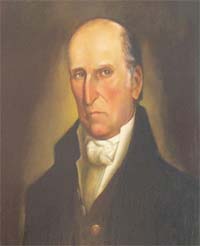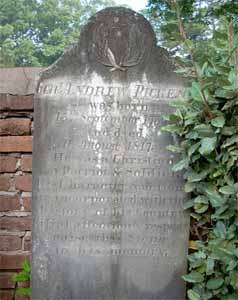I am going out on a very long and shaky limb with this post. I have decided to add a bit of culture to my musings on the time of the American War for Independence, also known as the era of the Yankee Doodle Spies. Music is a reflection of the society and culture from which it springs: aspirations, frustrations, and dreams all collide in a mix that is meant to inspire, influence, and sometimes just entertain. Whether music is composed for the concert hall, salon, church, or tavern, it has an effect on society and sometimes helps transform it. Since the American Revolution was one of the most transformative events in history, its music bears some attention. As I write, I happen to be listening to some of Haydn's string quartets, so I will focus on "serious" music during the time of the Yankee Doodle Spies in this post.
| Mozart |
Within the genre we call "classical" music, the eighteenth century was a time of transition from the Baroque period, which is actually referred to as the Classical period. In some ways, the transition mirrors the overall cultural shift during what is called the Age of Reason. During the eighteenth century, a new awakening to the study and appreciation of classical Greece and Rome led to a renewed interest in classical architecture, literature, arts, and history. The study of those once-forgotten languages experienced a resurgence. Oratory became an essential part of education, as did mathematics and science.
The evolution of music from the more formal and structured Baroque to the less formal and cleaner style of the Classical period is a manifestation of this transitional period. Such music was still closely associated with court culture and absolutism, characterized by its formality and emphasis on order and hierarchy. After all, these were the patrons, sponsors, and benefactors. They paid the bills. However, the new style was also "cleaner" - favoring clearer divisions between parts, starker contrasts, and simplicity over complexity. As the 18th century progressed, the nobility became the primary patrons of instrumental music, while public taste increasingly preferred comic opera. This led to changes in the way music was performed and written. The central figure of the last quarter of the century was, of course, Mozart. Wolfgang Amadeus Mozart's compositions characterized the music of the classical era.
 |
| Most gatherings included but a few instruments |
Across the ocean, things followed, albeit more slowly. The period of Puritan domination (That is, New England) was waning by the 1730s, and musical concerts began to spring up. The first public concert in America, of which we have a record, was held in Boston. This took place in 1731, at a time when the New England ban against secular music was gradually waning. The event, called "a Concert of Music on sundry Instruments," was held in "the great room" of a local dancing master, who was also a teacher, tradesman, and tobacco trader.
A few years later, Fanueil Hall began to be used for musical concerts. By 1754, there was a concert hall at the corner of Hanover and Court Streets in Boston. The next American city to have a public concert was Charleston, South Carolina. The upper classes already had their private recitals, dances, and such. Then came to New York. In 1736, a "Consort of Musick, Vocal, and Instrumental" was advertised, showcasing various instruments. Philadelphia had its first public concert in 1757.
But as the largest city in the American colonies, Philadelphia likely had private concerts previous to this, as it had a vibrant culture of entertainment (despite the strong Quaker influences). By the time of George Washington's era, the variety of musical instruments used in America was growing. As early as 1761, Washington ordered a spinet from England. The harpsichord, and later the piano-forte, were found in many homes and were used at concerts. Violins and cellos were well-known, and the versatile German flute grew in popularity.
The concert programs of the day offer a glimpse into the instruments most commonly used, as many of them announced the instrumentation of the orchestras that performed, as well as the instruments used by soloists. At least one concert in 1769 included solos on the violin, flute, clarinet, harpsichord, and mandolino. Other instruments used during the time of the Yankee Doodle Spies included the violin, the viola, flutes, and French horns. Trombones were in use, too.
popular instruments
According to one account, one night in 1755, some trombonists at Bethlehem, Pennsylvania, warded off an Indian attack by playing chorales. Trumpets were introduced in America in the early eighteenth century. Woodwinds, such as the oboe and the bassoon, were also beginning to appear. All of these were in very small numbers and scattered near the more developed parts of the colonies. The point is that by the mid-eighteenth century, the colonies were experiencing economic growth. Cultural expansion followed, and the tools (instruments) made their way across the ocean to fill the need.
 |
| The Snare Drum is one of the oldest military instruments |
During the mid-eighteenth century, American church music also began to emerge as a distinct entity. So-called Psalm Music was primarily vocal, as was most music in colonial America. The great religious awakening of the mid-century spurred it on. Regardless, this was the harbinger of the unique relationship between church and secular that exists even today. It should be remembered that the same phenomena existed in Europe as well. Most musicians wrote for both audiences.
The military also had an impact on musical appreciation during the American Revolution. Military bands had both “field music,” primarily fife and drum, to move troops around the battlefield as well as “bands of music.’ The latter were small ensembles hired by officers to play at balls, fetes, and sometimes for the public. These were the antecedents to the later 19th-century bands that became popular in America and Europe and still perform public functions today. The music played on the fife and drum can be identified from published tutors and from tune books written out by the players themselves. Giles Gibbs's. The Book for the Fife (1777) represented all the music needed for an army, including military signals and marches, as well as dances, songs, and hymns. It also includes the music to the song we know today as "Yankee Doodle."
 |
| Military bands came into their own during the struggle for independence |
In the fall of 1768, British troops landed in Boston to protect crown officials who were being harassed by local citizens and could not carry out their duties. The British regiments had bands of music attached to them. By 1769 these bands were participating in public concerts. The programs included symphonies, concertos, overtures, and songs—not military music, but typical eighteenth-century concert fare. Americans organized their military units along British lines, and military musicians were part of the plan.
British Bands helped inspire Loyalty to the Crown
The Continental Army, consisting of one artillery and twenty-seven infantry regiments, was formed from the various state militias. Each regiment had eight companies of ninety officers and men, including two fifers and two drummers. Drum majors and fife majors were also appointed in many regiments to instruct and lead the field music. The organization thus provided positions quite a number of fifers and drummers alone—448 of each. Whether or not all fife and drum positions were filled, military music had a forcible impact on the atmosphere of American towns and cities after the outbreak of the war.
The Continental Army Bands also inspired Patriotism
Legend has it that at the surrender of General Cornwallis’s troops ending the siege of Yorktown, a British military band played a popular tune of the period as the British and Hessians grounded their arms: “The World Turned Upside Down.” There is no contemporary account of this (the story grew out of an early 19th-century memoir) but clearly, the very idea that a musical theme should accompany such a momentous occasion completes the cycle that made music a central part of American culture in the years following America's independence.
 |
| The World Turned Upside Down? Musically, politically... |
A future look at music during the Revolutionary War will focus on the “pop music” of the day. Songs sung by the masses were used by both sides to rally support for their causes. Out of that genre came the first composer born in America, whom we shall meet another time.
















